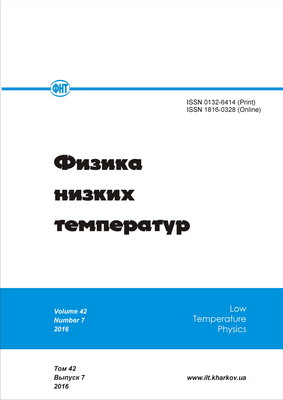
Бази даних
Наукова періодика України - результати пошуку
 |
Для швидкої роботи та реалізації всіх функціональних можливостей пошукової системи використовуйте браузер "Mozilla Firefox" |
|
|
Повнотекстовий пошук
| Знайдено в інших БД: | Реферативна база даних (16) |
Список видань за алфавітом назв: Авторський покажчик Покажчик назв публікацій  |
Пошуковий запит: (<.>A=Bagatskii M$<.>) | |||
|
Загальна кількість знайдених документів : 7 Представлено документи з 1 до 7 |
|||
| 1. | 
Bagatskii M. I. Low-temperature dynamics of matrix isolated methane molecules in fullerite C60. The heat capacity, isotope effects [Електронний ресурс] / M. I. Bagatskii, V. G. Manzhelii, V. V. Sumarokov, A. V. Dolbin, M. S. Barabashko, B. Sundqvist // Физика низких температур. - 2014. - Т. 40, № 8. - С. 873-880. - Режим доступу: http://nbuv.gov.ua/UJRN/PhNT_2014_40_8_4 The heat capacity of the interstitial solid solution (CH | ||
| 2. | 
Bagatskii M. I. The heat capacity of nitrogen chain in grooves of single-walled carbon nanotube bundles [Електронний ресурс] / M. I. Bagatskii, M. S. Barabashko, V. V. Sumarokov // Физика низких температур. - 2013. - Т. 39, № 5. - С. 568-573. - Режим доступу: http://nbuv.gov.ua/UJRN/PhNT_2013_39_5_11 The heat capacity of bundles of closed-cap single-walled carbon nanotubes with one-dimensional chains of nitrogen molecules adsorbed in the grooves has been first experimentally studied at temperatures from 2 to 40 K using an adiabatic calorimeter. The contribution of nitrogen <$EC sub roman N2> to the total heat capacity has been separated. In the region 28 K the behavior of the curve <$EC sub roman N2 (T)> is qualitatively similar to the theoretical prediction of the phonon heat capacity of 1D chains of Kr atoms localized in the grooves of SWNT bundles. Below 3 K the dependence <$EC sub roman N2 (T)> is linear. Above 8 K the dependence <$EC sub roman N2 (T)> becomes steeper in comparison with the case of Kr atoms. This behavior of the heat capacity <$EC sub roman N2 (T)> is due to the contribution of the rotational degrees of freedom of the N | ||
| 3. | 
Bagatskii M. I. Experimental low-temperature heat capacity of one-dimensional xenon adsorbate chains in the grooves of carbon c-SWNT bundles [Електронний ресурс] / M. I. Bagatskii, V. G. Manzhelii, V. V. Sumarokov, M. S. Barabashko // Физика низких температур. - 2013. - Т. 39, № 7. - С. 801-805. - Режим доступу: http://nbuv.gov.ua/UJRN/PhNT_2013_39_7_10 The experimental studies of the heat capacity of 1D chains of xenon atoms adsorbed in the outer grooves of bundles of closed single-walled carbon nanotubes <$EC sub roman Xe> have been first made at temperature range 2 - 30 K with the adiabatic calorimeter. The experimental data <$EC sub roman Xe> have been compared with theory [A. Siber, Phys. Rev. B 66, 235414 (2002)]. The experimental and theoretical heat capacity curves are close below 8 K. Above 8 K the experimental curve <$EC sub roman Xe (T)> exceeds the theoretical one and excess capacity <$Eroman D C sub roman Xe (T)> increases monotonously with temperature. We assume that the <$Eroman D C sub roman Xe (T)> caused mainly by the increase of the distance between the neighboring xenon atoms in the chain with increasing temperature. | ||
| 4. | 
Bagatskii M. I. A simple low-temperature adiabatic calorimeter for small samples [Електронний ресурс] / M. I. Bagatskii, V. V. Sumarokov, A. V. Dolbin // Физика низких температур. - 2011. - Т. 37, № 5. - С. 535-538. - Режим доступу: http://nbuv.gov.ua/UJRN/PhNT_2011_37_5_17 A simple adiabatic calorimeter has been made to investigate the heat capacity of small samples of carbon nanomaterials in the temperature range from 1 to 300 K. It makes possible: short-time mounting of a sample; doping of samples with gases directly in the calorimeter; short-time cooling of a sample down to helium temperatures. The adiabatic calorimeter is suitable to place into a helium vessel of a portable Dewar or a helium cryostat. The heat capacity of the fullerit sample has been measured in the temperature range from 1 to 30 K. | ||
| 5. | 
Bagatskii M. I. Low-temperature heat capacity of fullerite C60-doped with deuteromethane [Електронний ресурс] / M. I. Bagatskii, V. V. Sumarokov, A. V. Dolbin, B. Sundqvist // Физика низких температур. - 2012. - Т. 38, № 1. - С. 87-94. - Режим доступу: http://nbuv.gov.ua/UJRN/PhNT_2012_38_1_14 The heat capacity C | ||
| 6. | 
Bagatskii M. I. The specific heat and the radial thermal expansion of bundles of single-walled carbon nanotubes [Електронний ресурс] / M. I. Bagatskii, M. S. Barabashko, A. V. Dolbin, V. V. Sumarokov, B. Sundqvist // Физика низких температур. - 2012. - Т. 38, № 6. - С. 667-673. - Режим доступу: http://nbuv.gov.ua/UJRN/PhNT_2012_38_6_13 The specific heat at constant pressure C(T) | ||
| 7. | 
Sumarokov V. V. The low-temperature specific heat of thermal reduced graphene oxide [Електронний ресурс] / V. V. Sumarokov, A. Jeżowski, D. Szewczyk, A. V. Dolbin, N. A. Vinnikov, M. I. Bagatskii // Фізика низьких температур. - 2020. - Т. 46, Вип. 3. - С. 364-368. - Режим доступу: http://nbuv.gov.ua/UJRN/PhNT_2020_46_3_13 Питому теплоємність багатостінних вуглецевих нанотрубок (БСВНТ) з низькою дефектністю та низьким вмістом неорганічних домішок виміряно в діапазоні температур 1,8 - 275 К методом теплової релаксації. Зразки БСВНТ отримано хімічним каталітичним осадженням з парової фази. Елементний склад і морфологію БСВНТ визначено за допомогою скануючої електронної мікроскопії та енергодисперсійної рентгенівської спектроскопії. Нанотрубки мали середній діаметр від 7 до 18 нм і довжину в кілька десятків мікрон. Чистота БСВНТ була більш ніж 99,4 ат. %. Маса зразків становила від 2 до 4 мг. Виявлено, що температурна залежність питомої теплоємності БСВНТ значно відрізняється від теплоємності інших вуглецевих матеріалів (графена, в'язок ОСВНТ, графіту, алмазу) за низьких температур. Теплоємність БСВНТ систематично зменшується зі збільшенням діаметра нанотрубок за низьких температур. Температурні залежності питомої теплоємності БСВНТ із різними діаметрами демонструють притаманний низьковимірним системам характер від 1D до 3D залежності від температурних областей. Температури кросовера складають близько 6 і 40 К. Поблизу цих температур спостерігається гістерезис.Вимірювання теплоємності за постійного тиску термічно відновленого оксиду графену (trGO) та оксиду графіту (GtO) проведено методом термічної релаксації в діапазоні температур від 1,8 до 275 K. Вище 15 K значення питомої теплоємності trGO та GtO є близькими між собою в межах 20 %. Нижче 10 K відношення питомої теплоємності trGO до питомої теплоємності GtO збільшується зі зменшенням температури та досягає 5 при 2 K. Встановлено, що температурна залежність питомої теплоємності trGO має складний характер. Існують температурні діапазони, у яких питома теплоємність trGO або ~ T, або ~ T<^>2,5 | ||
 |
| Відділ наукової організації електронних інформаційних ресурсів |
 Пам`ятка користувача Пам`ятка користувача |